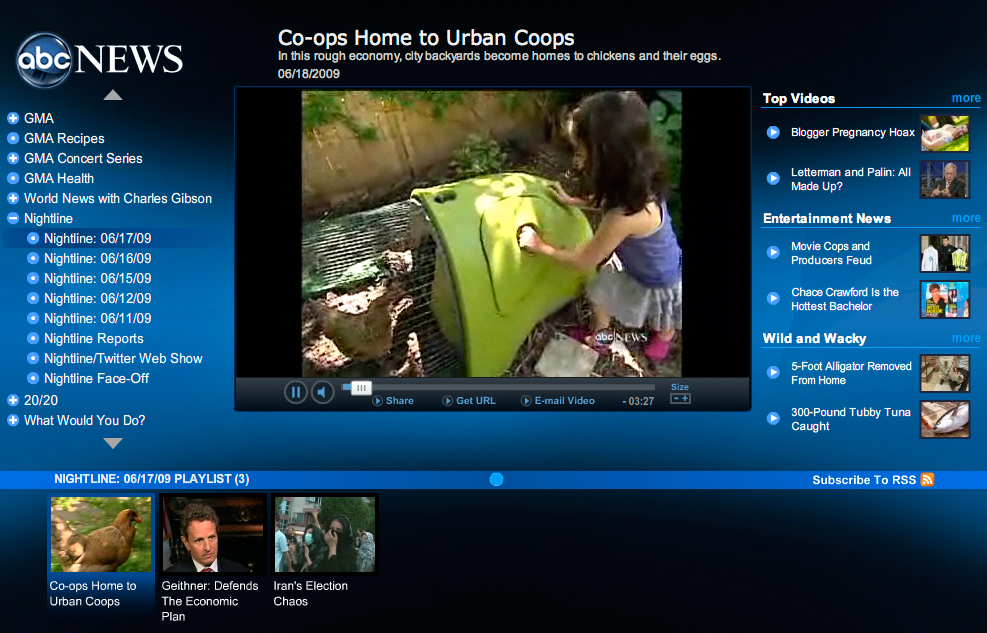The segment Co-ops Home to Urban Coops ran on Nightline last night. You can watch the segment here. I think the girls did a great job! They also showed the website My Pet Chicken, which is where we got our girls.
Tag Archives: backyard chickens
Chickens on Nightline 6/17
A couple of weeks ago a crew came from ABCs Nightline to talk to us about urban chicken keeping. They said that they would air the show tonight at 11:35. I hope I don’t look like the crazy chicken lady….
I’ll post a link to the segment when it’s on their website. That is, if I don’t look like too much of a dork.
The story of our urban chickens
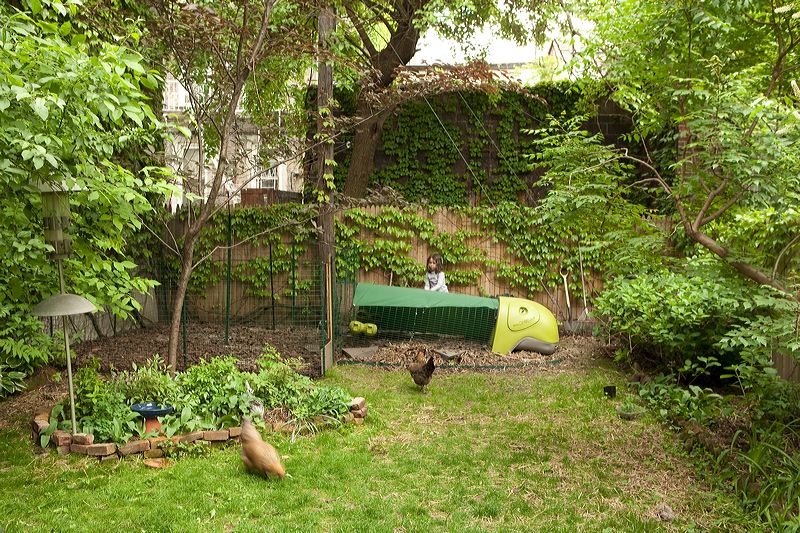
Almost a year ago my family decided to get chickens for our urban backyard. I thought I would write about our experiences because of the growing interest in backyard chicken-keeping.
After reading and researching and convincing my family, we ordered three day-old chicks to start our backyard flock. If you aren’t familiar with ordering livestock, it arrives via the United States Post.
Last July I got a call from my local post office saying that our chicks had arrived and in less than 10 minutes the mailman was at our door with a box emitting tiny peeping noises. I think he was happy to pass off this noisy box and get on with his regular, less-insistent packages!
Most hatcheries that sell mail-order chicks have a minimum order of 24 chicks. The large numbers of chicks in the box help keep them warm, which is crucial for the babies survival. These minimums are large enough that it prevents most hobbyists from ordering. Some people solve the problem by splitting their orders with friends. This is a great solution, but sometimes hard to coordinate. Mypetchicken.com stepped in to help urban chicken keepers. For people living in urban centers, they offer a minimum order of 3 chicks. They have special packaging that has a cushioning nest, green nutritious/hydrating gel and they include a heat pack if the weather is cool. Since my order came in July, they didn’t need to include the heat pack. Here’s a photo of my chicks when we opened the box.
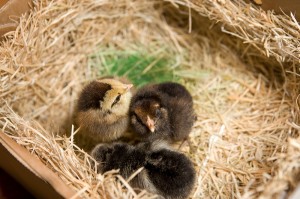
our 3 day-old chicks in the box they were mailed in
The chicks need some special care when they first arrive. They can be very stressed from the journey, and will need to have access to water immediately. You can gently dunk their beaks in their water dish to teach them where to find water. Also check their little butts to make sure they aren’t pasted up with droppings. The chicks need to be kept in a special place called a brooder that is warm and away from drafts. You should have the brooder already set up for their arrival. The brooder can be an old aquarium, cardboard box, Rubbermaid tub…you get the idea. I made mine out of an old hamster cage and put cardboard around the sides to protect from drafts and paper towels on the bottom to keep them from slipping on the plastic. I bought a heat lamp from my local hardware store.
To feed them you will need chick crumbles and fresh water (very shallow, so they can’t fall in and drown). They need to be warm. A guideline is 90-100ºF the first week and then 5ºF less each week. Check on how they act . If they are panting and huddling away from the heat source, it’s too hot. If they are mashed together in a ball under the light, it’s too cold. Take a peek at backyard chickens for more detailed instructions on raising your chicks during their first 60 days.
The chicks sleep a lot and will sometimes just sort of fall over. This can be a little disturbing to a newbie because it looks as though they’ve just keeled over.
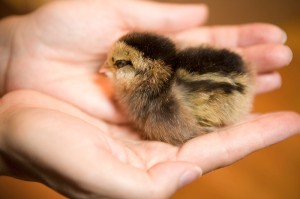
This little one is Edie. She’s the sweetest of the group. On her first day I held her for a few seconds and she drifted off to sleep in my hands. She’s what’s known as an Easter Egger chick, which is a mixed breed derived from the Araucana chicken. Easter Eggers aren’t a pure breed, but they have the same blue-green colored eggs of Araucanas.
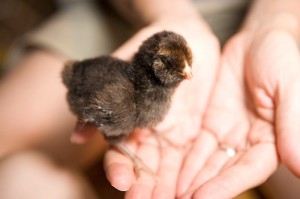
Louise or LouLou for short
This little pee-wee is LouLou and she’s an Easter Egger also. There is a huge variation of coloring with Easter Eggers. Interestingly enough, their coloring as chicks may bear little resemblance to their adult coloring. LouLou is the loudmouth, bratty little sister of the group. When her sisters are asleep, she chirps her head off to wake them up. I don’t know if her motivation stems from loneliness or sadism, but she’s got quite a personality. Despite her size, I’m putting my money on her to be the top of the pecking order.
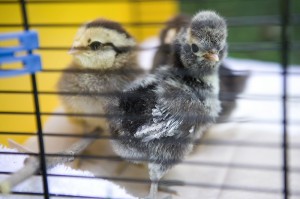
Andie and gang at 4 days
The gray one is Andie. She is a silver laced polish chick and will look like this when she grows up. The big pompom “hairdoo” she will get reminded us of Andy Warhol’s hair, so we kind of went with a theme of Andy Warhol’s Factory. LouLou is named for Lou Reed. Edie is for Edie Sedgwick and of course Andie is Andy Warhol. We joke that we have factory eggs, although these gals will be the farthest from factory hens you can imagine.
4 Days Old:
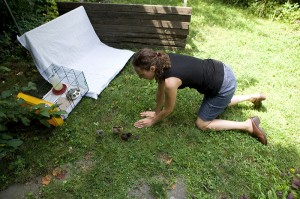
the chicks outside of their brooder for the first time
The rate of the chicks growth is amazing. Since the weather outside was as hot as their brooder, we decided to take them outside for a photo shoot. We put a blanket down to make a little photo sweep backdrop and put down our picnic table and brooder to try and keep them somewhat contained. They were pretty freaked out after my bumping them down our spiral staircase to the outside and kept very close to me. I think they see me as mama hen, which warms my little heart.
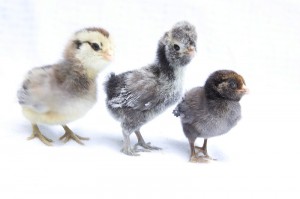
Edie, Andie and LouLou
You can get a pretty good idea of their respective sizes. LouLou is a little crouched down, but she’s definitely the smallest of the bunch. What she lacks in size, she makes up for in pushiness. You can see the tips of wing feathers starting to come in on Andie.
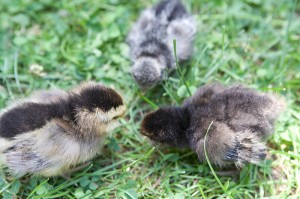
Once the girls got used to their new surroundings, they really started enjoying themselves. They had a blast pecking at the grass and scratching around on the ground. We’re going to take them outside for a few minutes each day to let them get used to the outdoors.
10 Days Old:
It’s been fascinating to watch the changes the chicks have already gone through. In their second week they have tripled in size, started to scratch the ground and learned to fly about 2 feet off the ground. They have quite a lot of feathers on their wings and have started to get silly little tail feathers. They start to look really mangy when their true feathers start peeking out of their baby fluff. It will be pretty hilarious to see how scruffy they look when the feathers on their necks and faces start to come in.
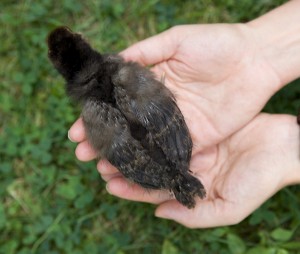
LouLou getting wing and tail feathers
LouLou has overtaken Andie in size and is still my bet for dominant hen. I’m crossing my fingers that she doesn’t end up being a rooster. I paid extra to get “sexed chicks” because roosters are illegal in NYC. There’s actually a job where someone looks at day-old chicks and determines their sex. They have a 90% accuracy rate. I read on a chicken forum the saying, “if it lays it stays and if it crows it goes”, which will certainly hold true here. I’m crossing my fingers that we have all girls because I’ve grown so attached to them.
Okay, now that I’ve just admitted I read chicken forums (or chicken porn as my husband refers to my late-night internet chicken research), I will attempt to distract you with cute chick photos…
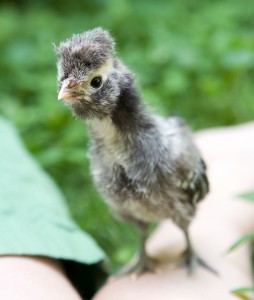
Andie looking like an ostrich
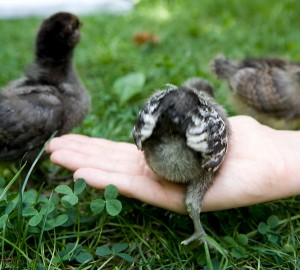
fuzzy butt
3 Weeks Old:
We’re going to stay at my in-law’s home in the Berkshires and are bringing the chicks with us. They are almost 2 weeks old and we’ve upgraded to a dog crate to accommodate for their exponential growth. We’ve nicknamed our minivan “gypsy” because we are now traveling with livestock. I guess goats will be next!
In the meantime, take a peek at some beautiful pen and ink drawings of chicks growing up by Kip Mieke Roth.
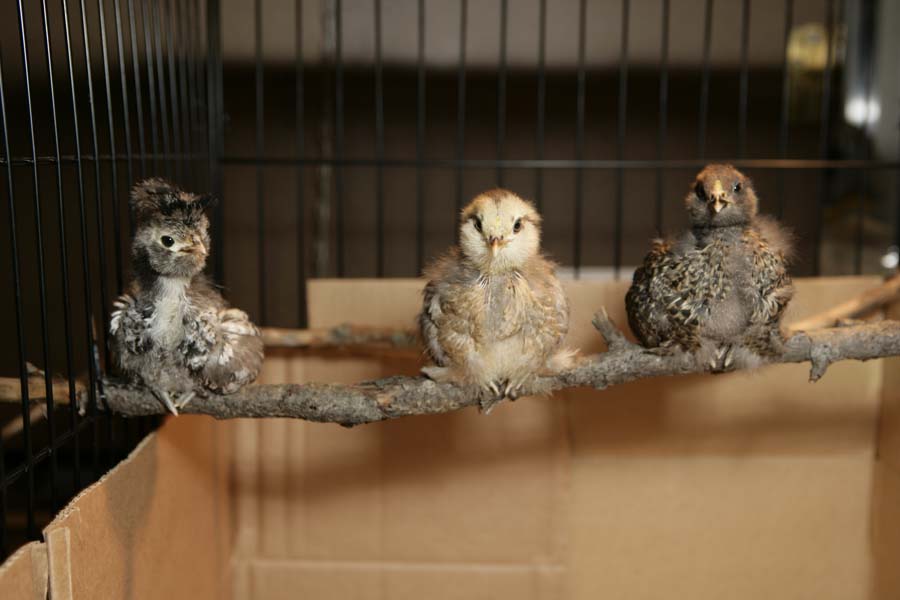
We found a nice stick to use as a perch on one of our nature hikes in the Berkshires. They immediately hopped on and now sleep on their perches. At 3 weeks, they have a lot of feathers, but still need the heat lamp until their feathers have filled in a bit more. I only turn it on at night when the temperature drops. The cardboard around the bottom of their cage isn’t so much for drafts as it is to keep the mess down. Chickens love to scratch! These girls dig and scratch and kick around in their pine shaving bedding and have a grand old time. The mess they make with the shavings is pretty impressive, and since we’re staying at someone else’s house, I want to do my best to keep the mess down. They look less like chickens to me and more like owls or some sort of forest creature. Andie is sporting a very ratty looking mohawk.
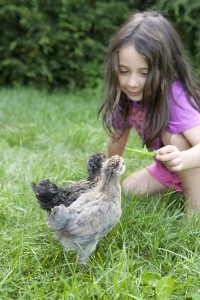
Lindsay playing with the girls
Our daughter Lindsay is really enjoying the chicks. She is 4 years old and is very gentle with them. I’m less worried now that they have grown so much in size. LouLou is on the left and Edie is on the right. They have gotten most of their feathers in the days between 2 and 3 weeks. They enjoy munching on grass and eating the mosquitoes that I smack on my legs and hand to them. Gotta give them a taste for those buggers!
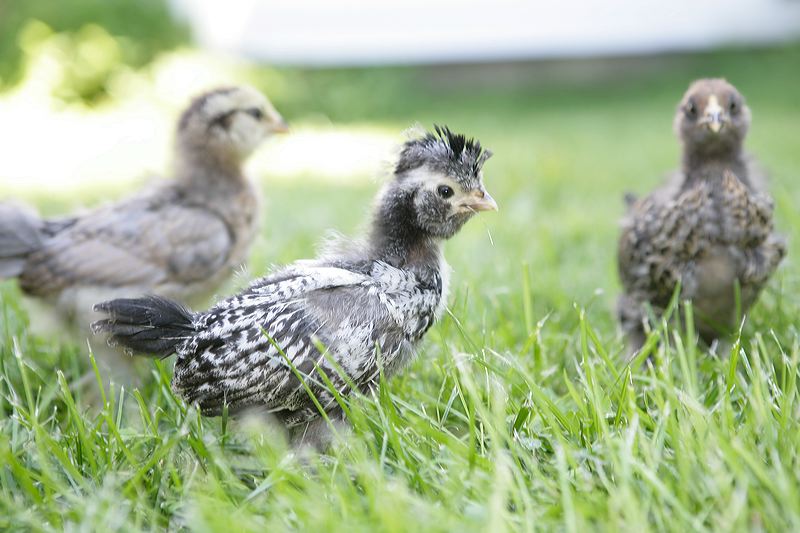
6 Weeks Old:
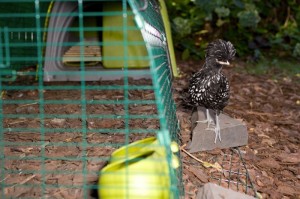
Andie next to the coop
The coop arrived a few weeks ago and the girls are now used to living outdoors. We ordered The Eglu by Omlet, which is probably one of the fanciest coops on the market. Part of the stipulation (from my once-skeptical husband) of getting chickens was that our backyard shouldn’t look like a run-down barnyard. The Eglu looks a bit like the old IMacs, is predator proof (we have raccoons and hawks here in Brooklyn) and easy to clean. You can see their water bowls in the foreground of the wire run and the perches through the (close-able) door to the insulated coop.
The first photo shows Andie with her increasingly crazy hair-doo outside the coop for a little free-ranging. Chickens are omnivores and love a varied diet. They love all kinds of insects, slugs and mosquitoes, which give them protein. They also love to eat grass and plants, which provide them with a rich source of beta-carotene that the mostly corn-fed factory chickens don’t get. The yolks of grass-fed chickens are a much deeper, richer yellow than we are used to getting from the grocery stores here. In Europe, the grocery store eggs still have quite orange yolks. My girls haven’t started producing eggs yet. I expect that will happen around Christmas/The New Year.
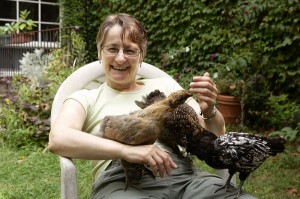
my friend Ruth with the girls
This photo shows my friend Ruth the chick magnet. It really shows how curious and friendly the chicks are. They have been used to being around people, so they flock around us whenever they are out of their coop. They still make cheep cheep sounds, although we get the occasional bwock sound.
9 Weeks Old:

Edie with a beard
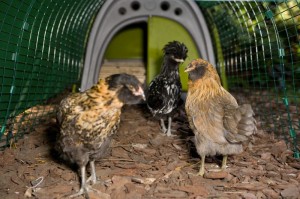
LouLou, Andie and Edie
We got back from a visit to my father in France to discover some of our girls grew beards! Edie, pictured above was the little one who looked like a chipmunk originally. LouLou has grown orange and brown feathers in place of her all-dark baby fluff, and Andie has spectacular black and white feathers and a crazy pompom hairdoo now.
29 Weeks Old:
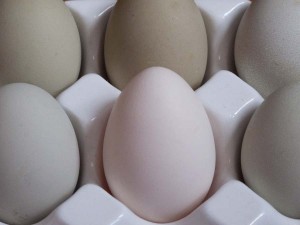
first eggs
We can now fast-forward a bit to when the girls started to lay. LouLou was the first to lay an egg (on Groundhog’s Day) and you can catch up with that in my post here. You can tell when your chicks are about to get ready to lay when their combs turn red. You can see in the photo of Edie above that her comb hasn’t really developed and is quite pale. I can tell which hen laid which egg because each one is a slightly different color. LouLou’s are sage green, Edie’s are a pale blue and Andie’s are white.
We have enjoyed our chickens tremendously and highly recommend chicken keeping to almost anyone. We felt like first-time parents as we watched our chicks grow into hens. We love the rich, “meaty” eggs they give us. How many people have pets that make them breakfast?? What was really important to us was that our “city girl” daughter would grow up knowing where her food comes from, and now she does.
I will write more about the nuts and bolts of keeping city chickens in my next post.
The Backyard

When I first mentioned to Neil that I wanted chickens, his initial response wasn’t very positive. He grew up in the Berkshires and sometimes the farm aesthetic was pretty awful. We have a small yard, so any chicken coop we got (I was working on him!) had to be attractive. We spent way too much money on the Eglu by Omlet. It’s a beautiful coop and very easy to clean, which was a big bonus for me.
So everything was going well in our beautiful backyard farm until I took a couple of composting classes at the Brooklyn Botanic Garden. The teacher was great and very inspiring as to how to scavenge materials in the city. Coffee grounds from your local coffee shop, bales of straw from neighbor’s Halloween displays, etc. It was armed with the information from this class that I purchased a Toro leaf blower and decided to vacuum and mulch my leaves. It actually took a lot of restraint not to become the crazy leaf lady and walk up and down my block vacuuming up the neighbor’s leaves. Hey, I only have a finite amount of “browns” for my compost bin!
Well then I happened upon an autumnal display (this was in October) that had bales of straw and quickly asked them if I could have the straw when they were done with it. I was able to cart off 2 bales. Those suckers are big and heavy and you definitely look like the crazy straw lady when you are wrestling them down the streets of Brooklyn on a cart. I generously spread a layer all over the backyard and piled the straw up in the plant beds. I was glowing with how the straw would break down by the springtime and help my crummy lifeless soil become rich with nutrients and life. Neil was skeptical, but has gotten used to my crazy schemes, so he didn’t grumble too much.
It is now spring and as you can see from the photos, I have plenty of straw on the ground and in the beds. It has shown very little signs of breaking down. The grumbling has gotten quite audible. I planted grass seeds and there are tiny little green hairs peeking up. Hasn’t shown any sign of covering up the straw.

Even I have to admit that my fabulous composting endeavor looks pretty awful. People who come over think that the straw is for the chickens and this is exactly what Neil wanted to avoid in the first place. Neil encouraged me to pull out the leaf blower to suck up some of the straw and grind it into smaller pieces. That seemed to work, but I didn’t put it all back. I think I will dig it into the beds over the summer and fall and add it to my compost bin. I think the grass will grow through what’s left and my backyard will look a little less like photos from the Dust bowl fairly soon. Cross your fingers!
Mad City Chickens
A year after “Mad City Chickens” played to a sold-out, enthusiastic crowd at the Wisconsin Film Festival, the documentary has found a niche with foodies and, beginning this week, a new life on DVD.
The Mount Horeb filmmakers spent more than two years researching the backyard chicken phenomenon in the United States. The film centers on how Madison has become a hotbed for urban chickens, looking at how the laws changed in Madison to allow coops, and what drives urban dwellers to keep chickens for eggs and grow to love the creatures.
“I was thinking it would be a 10-minute film; Tashai thought maybe half an hour,” Lughai said. “We were just going to shoot this film because we like chickens ourselves, but the problem was it was too damn interesting.”
Forty hours of interviews became a 79-minute film (the couple trimmed four minutes from the big-screen version for the DVD). There is nearly an hour’s worth of extras, including more from Mother Earth Editor Cheryl Long, some tips for keeping backyard chickens and a making-of featurette.
“The featurette tells us how it grew and how somebody told us about somebody else,” Lughai said. “All these connections, and it just kept growing and growing. It could have kept growing, but we had to stop somewhere.”
Lovington and Lughai took great pains to make “Mad City Chickens” as entertaining as it is informative. So there are heart-tugging stories, such as the nearly dead chicken found on the road and rescued by Nutzy Mutz and Crazy Catz owner Liz Perry. And there are entertaining moments, such as a piano-playing chicken named Beanie.
“The original idea was to share that they can be more than food items,” Lovington said. “When we first got our chickens, I was excited about getting eggs. I didn’t realize you can have a relationship with them, and after we had them, it was a revelation. That was the first impetus — to share that with people.”
The film played at two film festivals in Canada after its world premiere at the Wisconsin Film Festival last April. Now, the couple is hearing more interest from food festivals. A showing is scheduled at the Santa Fe farmers’ market, at a food co-op in Moscow, Idaho, and at the Spring Film Festival presented by the Outpost Natural Foods Cooperative in Milwaukee.
“This is really attractive to food people — people in the food movement,” Lughai said. “The ‘Mad City Chickens’ group was really on the cutting edge. When they were getting their chicken laws changed, it wasn’t really a movement. It is a movement now, all over the place. I get e-mails from all over the U.S. and Canada; I’ve gotten e-mails from the UK, France and Italy. They asked us to submit to a slow food festival in Italy.”
This summer, “Mad City Chickens” will play at the Cottonwood Creek Environmental Film Festival in California, its first showing in the state.
“That’s cool because it’s right next to Escondido, where Beanie the piano-playing chicken lives,” Lughai said. “Jay Walker, who is out there, will finally get to see the film.”
Lughai doesn’t know if Beanie will be around to enjoy it, though. The filmmakers haven’t been in touch with Walker lately, and Beanie’s blog hasn’t been updated for almost a year.
The chickens have kept Lovington and Lughai busy, but they have other projects in the works. Both are feature films. One is a period piece set in rural England that they’ll film here. Another is a story inspired by their time raising puppies that will become guide dogs.
But they’ll also be spending time promoting the “Mad City Chicken” DVD. To order a copy, go here. The DVD sells for $21.95.
More backyard chicken eggs
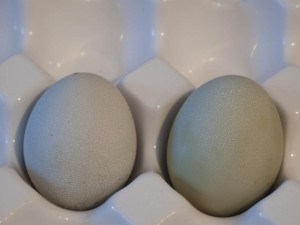
2nd egg
Yesterday I got the second egg from my hen Lulu. In Europe when you go to buy eggs, you don’t find them in the refrigerated section of the grocery store. They sit in big open cartons on the shelf. This makes most Americans squeamish about bacteria, salmonella, and anything else that could make them sick. It’s pretty cold in my apartment, so I think I’m somewhere in the middle of this debate by having them on my kitchen table. I may re-think this in the summer.
I have to admit that I’m having a hard time thinking about eating these eggs. Part of it is the novelty of them. They are pretty, little greenish-gray objects. I hate to admit that I have been so programmed to buy brown or white eggs from a carton in the grocery store, that I’m feeling a little squeamish. Eggs from my backyard? Seems as unlikely as picking fruit off one of my trees. I have been working so hard not to have this cultural programming in my daughter by planting blueberry bushes at her grandparent’s house, going to goat farms, picking wild raspberries and blackberries, eating icicles. She wants me to make her scrambled eggs with these eggs already! I think she will help me get over the preciousness and oddity of homegrown eggs.
Mother Earth News has been testing the nutrients of pastured eggs compared with those of commercial eggs. Pastured eggs meaning that they are eggs from hens that are allowed to roam and supplement their grain-based diet with plants such as grass and insects. Eating plants adds beta carotene to their diet and eating insects benefits almost everyone else.
The pastured eggs contained:
1/3 less cholesterol
1/4 less saturated fat
2/3 more vitamin A
2 times more omega-3 fatty acids
3 times more vitamin E
7 times more beta carotene
That’s pretty impressive. I think I’ll make Lindsay those eggs for breakfast tomorrow!
My first egg!!!
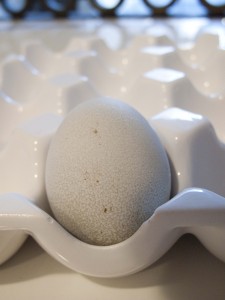
1st egg
Imagine my surprise when I saw a little blue/green egg sitting next to the golf ball. (You put a golf ball or other round object in the next box to give them a subtle hint as to where to lay their eggs) By process of elimination, I think it was Lulu who laid the egg. Andy should lay white eggs, so it was either Lulu or Edie. Lulu’s comb is a much darker red than Edie’s. When hens mature and are ready to lay, their combs turn bright red. So I think Lulu’s the one. I feel like a proud mommy.
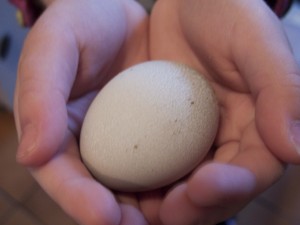
U.S. City Dwellers Flock to Raising Chickens

by Ben Block on October 6, 2008
They arrived when a member of BackyardChickens, an online forum, ordered the birds in the mail this past May. “I actually get my chicks in today hopefully, and I am worried that animal control will be at the post office waiting for me with hand-cuffs,” the new poultry farmer wrote.
An underground “urban chicken” movement has swept across the United States in recent years. Cities such as Boston, Massachusetts, and Madison, Wisconsin, are known to have had chickens residing illegally
behind city fences.
But grassroots campaigns, often inspired by the expanding movement to buy locally produced food, are leading municipalities to allow limited numbers of hens within city limits.
Cities such as Anne Arbor, Michigan; Ft. Collins, Colorado; and South Portland, Maine have all voted in the past year to allow residents to raise backyard poultry. "It’s a serious issue – it’s no yolk,” said Mayor Dave Cieslewicz of Madison, Wisconsin, when his city reversed its poultry ban in 2004. “Chickens are really bringing us together as a community. For too long they’ve been cooped up.”
Raising backyard chickens is an extension of an urban farming movement that has gained popularity nationwide. Home-raised livestock or agriculture avoids the energy usage and carbon emissions typically associated with transporting food.
“Fresh is not what you buy at the grocery store. Fresh is when you go into your backyard, put it in your bag, and eat it,” said Carol-Ann Sayle, co-owner of five-acre (two-hectare) farm in Austin, Texas, located within walking distance from the state capitol. “Everyone should have their own henhouse in their own backyard.”
“Buying local” also provides an alternative to factory farms that pollute local ecosystems with significant amounts of animal waste – which can at times exceed the waste from a small U.S. city, a government report revealed last month. In the United States alone, industrial livestock production generates 500 million tons of manure every year. The waste also emits potent greenhouse gases, especially methane, which has 23 times the global warming potential of carbon dioxide.
Meanwhile, advocates insist that birds raised on a small scale are less likely to carry diseases than factory-farmed poultry, although some public health officials are concerned that backyard chickens could elevate avian flu risks.
Chicken: The ‘Buy Local’ Mascot
After the trend first gained popularity in London, England, with the invention of the “eglu” chicken house about ten years ago, large numbers of city dwellers began to raise chickens in the U.S. cities of Seattle and Portland, said Jac Smit, president of the Urban Agriculture Network. “It’s no longer something kinky or interesting,” Smit said. “The ‘chicken underground’ has really spread so widely and has so much support.”
Within the past five years, the trend has expanded to cities where raising hens was already legal, including Los Angeles, San Francisco, and Chicago.
“Chicken has become the symbol, a mascot even, of the local food movement,” said Owen Taylor of New York City, who knows of at least 30 community gardens that raise poultry, mostly for their eggs. One Brooklyn home has raised upward of 50 hens. “We’re the biggest city in the country, so to have it here I think blows people’s minds.”
K.T. LaBadie, a University of New Mexico graduate student, was born into a family that grew its own fruits and vegetables. So when she moved to Albuquerque and met a friend who was raising his own chickens, poultry was a logical progression in her own home. She began with two hens, and now she has four.
“It felt like a good compliment to our backyard gardening. We get compost from the chickens that goes back into the vegetable beds,” LaBadie said. “And there’s really nothing better than harvesting tomatoes and peppers from your garden and being able to make an omelet with it using a meal that was based in your backyard.”
The spread of backyard chickens has promoted spin-off businesses that cater to the local market. Some communities are relying on mobile slaughterhouses to manage and distribute the poultry meat, according to Smit. “It’s no longer huge slaughterhouses doing millions [of birds]. It’s a guy driving around on a truck, visiting neighborhood to neighborhood,” he said. “And it’s not chickens only…. Ducks, turkey, and quail are particularly attractive.”
In Portland, Oregon, residents have organized a farming cooperative to raise hens for egg production. “The money is used to maintain the cooperative. It’s not necessarily organized to be a profit-sharing venture,” said Debra Lippoldt, executive director of Growing Gardens, a Portland urban agriculture advocacy group.
Public Health Concerns
If avian influenza eventually evolves to infect humans, experts fear that backyard chickens will be vectors of the disease. Government officials have threatened to ban free-range chickens in cities in Thailand, Indonesia, and Hong Kong, where bird flu has spread in the past. Governments around the world are also concerned that wild fowl will infect backyard chickens, leading to calls for similar bans in the Canadian province of British Columbia and in Australia.
But several public health officials argue that homegrown poultry are not a disease threat if the chickens are properly maintained. “Make sure the roof of the pen has a solid cover to protect birds from fecal matter that may drop from birds flying overhead,” said University of California at Davis poultry specialist Francine Bradley in a statement released in 2005, at the peak of avian flu concerns. “We always tell people, don’t let anyone near your birds who doesn’t need to be there [due to fears of people carrying the virus].”
Sustainable farming advocates insist that backyard chickens are less of a concern than factory-farmed poultry, which the Pew Commission on Industrial Farm Animal Production has said poses serious risks of transmitting animal-borne diseases tohuman populations, especially due to the prevalence of antimicrobialresistance.
“When it comes to bird flu, diverse small-scale poultry farming is the solution, not the problem,” the international sustainable agriculture organization GRAIN concluded in a 2006 report.
For urban poultry farmers, a more relevant health issue is whether the chickens, which many owners consider to be pets, can survive urban wildlife, even in New York City. “It’s awful how often flocks are decimated by raccoons or hawks or possums,” said Owen Taylor, who runs the City Farms livestock program, an extension of the sustainable food organization Just Food.
As the backyard chicken movement spreads, urban farmers are finding new ways of experiencing city living, whether their chickens are pets or dinner. “Raising chickens on a backyard stoop, especially if you have children, is agreeable,” Smit said. “How you convince the kids you’ll cut its neck and eat it is another thing.”
Ben Block is a staff writer with the Worldwatch Institute. He can be reached at bblock@worldwatch.org.

